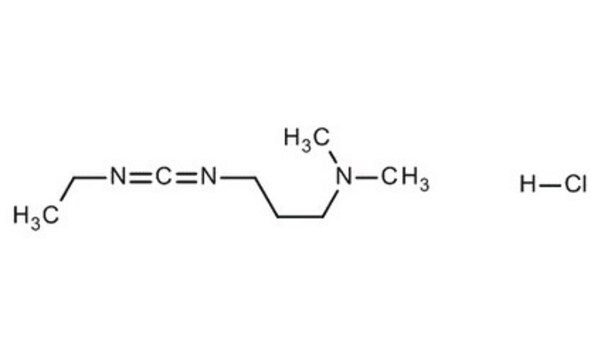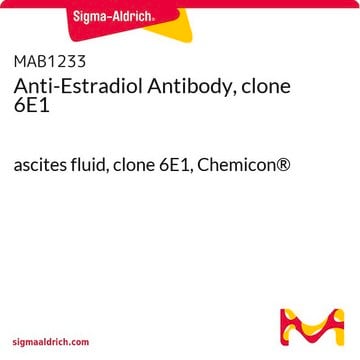Products may be shipped at a different temperature than the recommended long-term storage temperature. If the product quality is sensitive to short-term exposure to conditions other than the recommended long-term storage, it will be shipped on wet or dry-ice. If the product quality is NOT affected by short-term exposure to conditions other than the recommended long-term storage, it will be shipped at ambient temperature. As shipping routes are configured for minimum transit times, shipping at ambient temperature helps control shipping costs for our customers. For more information, please refer to the Storage and Transport Conditions document: https://www.sigmaaldrich.com/deepweb/assets/sigmaaldrich/marketing/global/documents/316/622/storage-transport-conditions-mk.pdf
165344
1-[3-(Dimethylamino)propyl]-3-ethylcarbodiimide methiodide
for peptide synthesis
Synonym(s):
EDC methiodide
About This Item
Recommended Products
Product Name
1-[3-(Dimethylamino)propyl]-3-ethylcarbodiimide methiodide,
form
powder
reaction suitability
reaction type: Coupling Reactions
mp
97-99 °C (lit.)
application(s)
peptide synthesis
functional group
amine
storage temp.
2-8°C
SMILES string
[I-].CCN=C=NCCC[N+](C)(C)C
InChI
1S/C9H20N3.HI/c1-5-10-9-11-7-6-8-12(2,3)4;/h5-8H2,1-4H3;1H/q+1;/p-1
InChI key
AGSKWMRPXWHSPF-UHFFFAOYSA-M
Related Categories
Application
- Crosslinking agent
Reactant for:
- Amide bond forming (amidation) crosslinking reactions
Signal Word
Warning
Hazard Statements
Precautionary Statements
Hazard Classifications
Acute Tox. 4 Dermal - Acute Tox. 4 Inhalation - Acute Tox. 4 Oral - Eye Irrit. 2 - Skin Irrit. 2 - STOT SE 3
Target Organs
Respiratory system
Storage Class Code
11 - Combustible Solids
WGK
WGK 1
Flash Point(F)
Not applicable
Flash Point(C)
Not applicable
Personal Protective Equipment
Choose from one of the most recent versions:
Already Own This Product?
Find documentation for the products that you have recently purchased in the Document Library.
Customers Also Viewed
-
How is shipping temperature determined? And how is it related to the product storage temperature?
1 answer-
Helpful?
-
-
How can I determine the shelf life / expiration / retest date of this product?
1 answer-
If this product has an expiration or retest date, it will be shown on the Certificate of Analysis (COA, CofA). If there is no retest or expiration date listed on the product's COA, we do not have suitable stability data to determine a shelf life. For these products, the only date on the COA will be the release date; a retest, expiration, or use-by-date will not be displayed.
For all products, we recommend handling per defined conditions as printed in our product literature and website product descriptions. We recommend that products should be routinely inspected by customers to ensure they perform as expected.
For products without retest or expiration dates, our standard warranty of 1 year from the date of shipment is applicable.
For more information, please refer to the Product Dating Information document: https://www.sigmaaldrich.com/deepweb/assets/sigmaaldrich/marketing/global/documents/449/386/product-dating-information-mk.pdfHelpful?
-
-
Is it possible to have EDC conjugated with a fluorophore such that it can still target Carboxyl groups on the cellular proteins
1 answer-
To target a carboxyl group on cellular proteins, the carbodiimide group of EDC must be unbound so the carbonyl from the carboxylic acid can initiate an attack. This interaction results in the formation of an O-acylisourea intermediate that can react with amines, with an urea by-product being released as a part of the process. Should a fluorophore be pre-conjugated to EDC, it is likely to be released as this by-product and thus would not attach to the carboxyl groups of the cells.
Helpful?
-
Active Filters
Our team of scientists has experience in all areas of research including Life Science, Material Science, Chemical Synthesis, Chromatography, Analytical and many others.
Contact Technical Service








